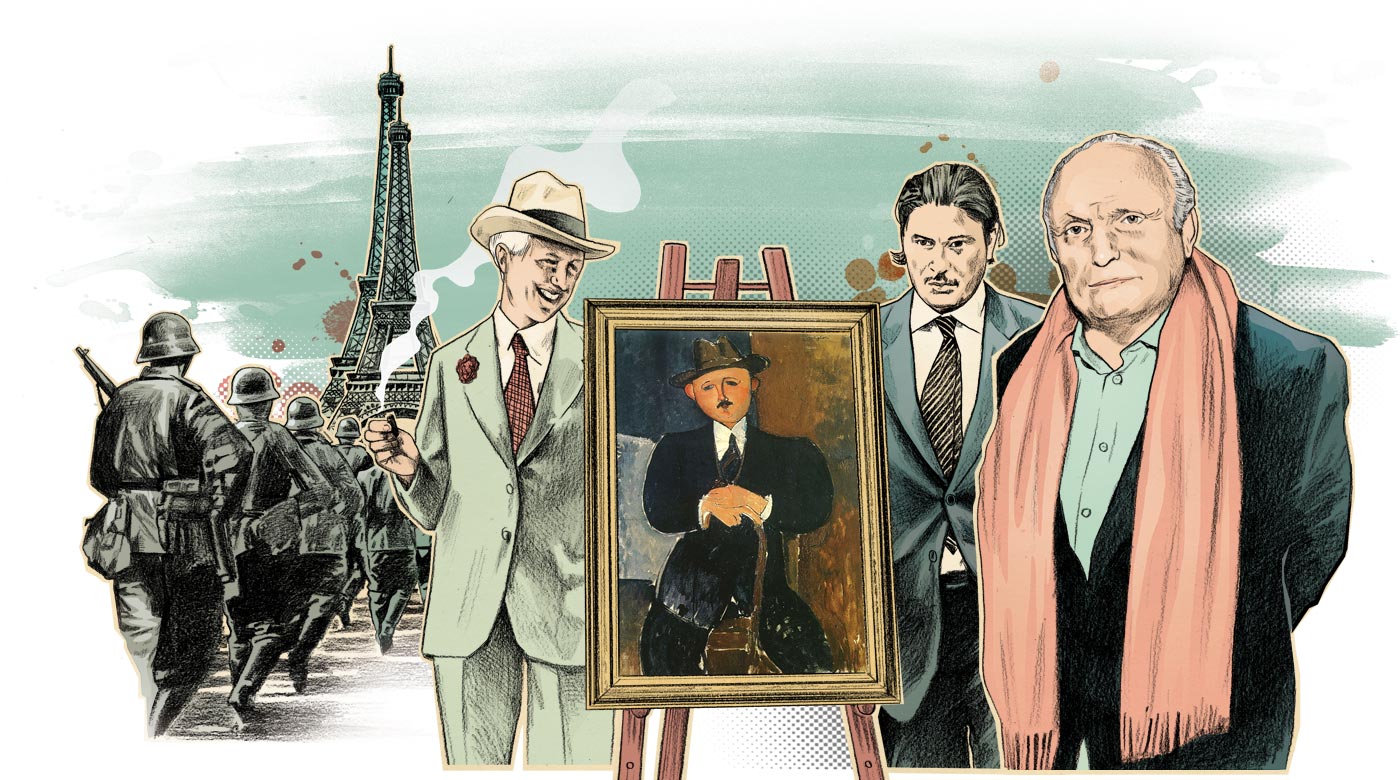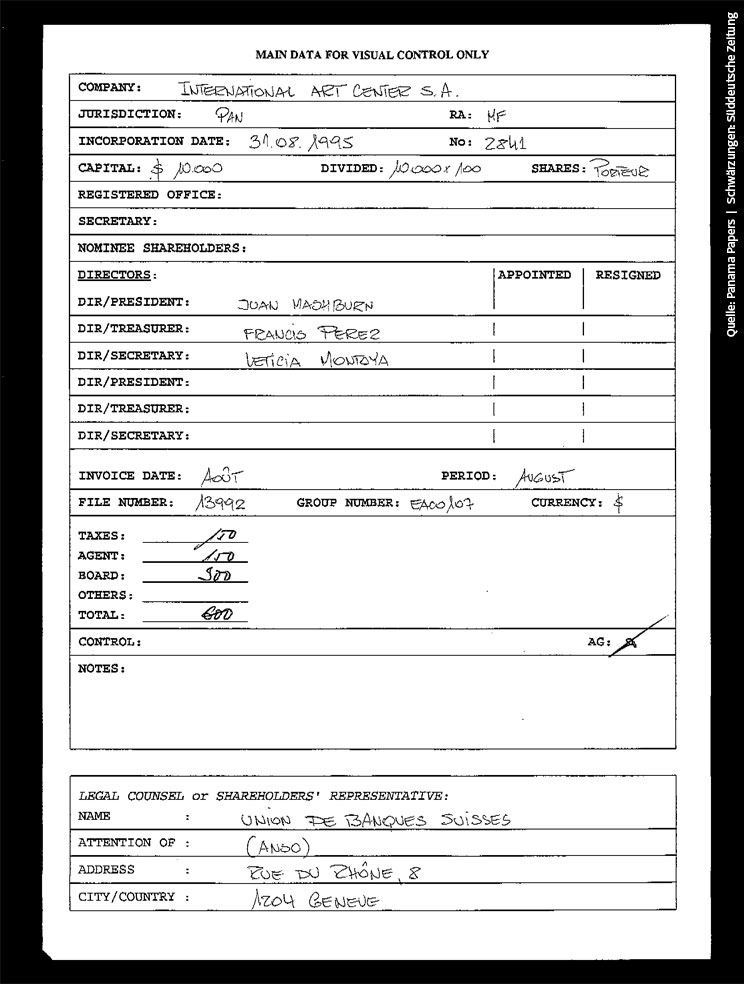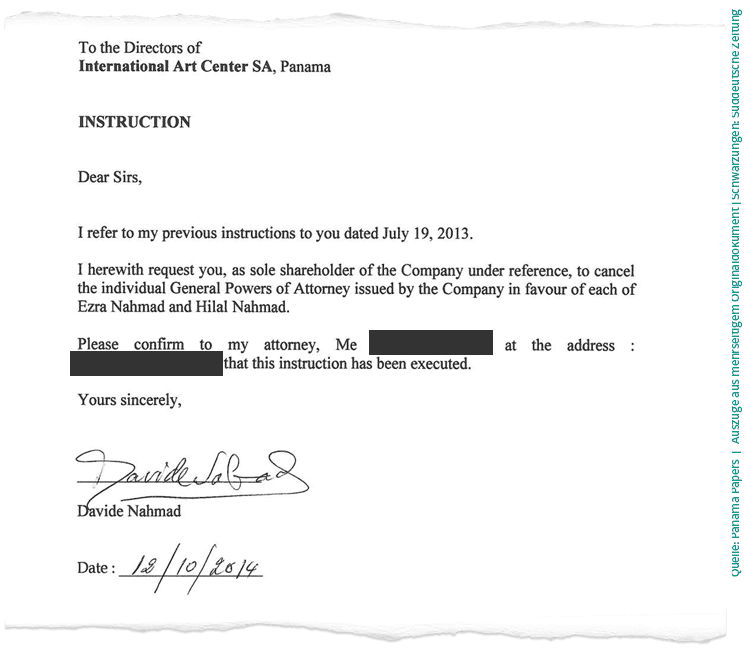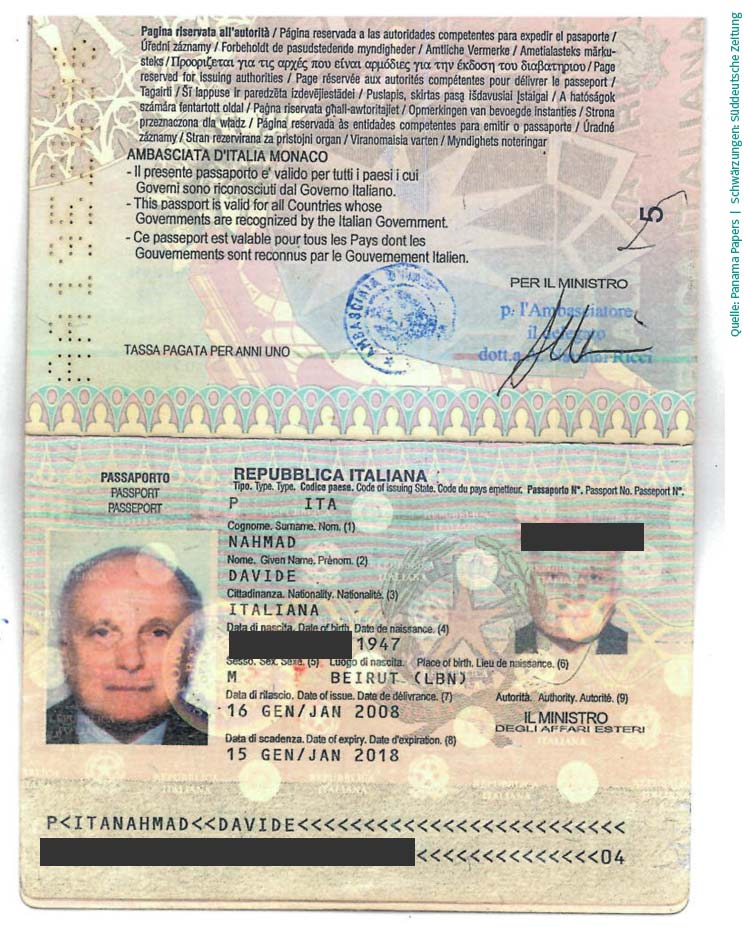
Panama Painting
A painting that has been missing for 52 years reappears and is sold, only to disappear again. The search for its true owner leads to Paris archives, London auction houses, and Swiss art warehouses, and ultimately ends in a New York City courtroom. The owner died long ago, and his grandson is currently engaged in a court battle with one of the world’s most famous and controversial art dealers. He wants the painting back that Nazis seized from his family. A team of journalists from Germany, France, Canada, and Switzerland traced the painting’s path, and found that it led into an underworld. For years, works of art disappeared into shell companies and lawyers tried to cover up the truth. Ultimately, the clues merge to form clear, logical evidence.
The letter
In the spring of 1946, Oscar Stettiner sat down in Paris and wrote a letter to the civil court on Rue du Cherche-Midi. The war had just ended, and the famine had been overcome. The Nazi occupation was history, and a new era was beginning to take shape in the ruins. Stettiner was a Jewish art dealer who ran his “Stettiner et Cie” gallery just a few streets away from the Seine on 18 Avenue Matignon in the eighth arrondissement. It was a good neighborhood, where the streets were lined with elegant townhouses. Born in Great Britain, Stettiner had been forced to leave Paris a few years before. In November 1939, seven months before the Germans invaded, he fled to La Force, the town in southern France where he grew up. Stettiner left his valuable art collection behind. Two years after his escape, the German occupiers hired an administrator for Stettiner’s gallery, the “Commissaire Gérant” Marcel Philippon. He sold off Stettiner’s property. Apart from his commission, the profit went to the National Socialists.While Stettiner, who was born in 1878, specialized in antique furniture and carpets, he fell in love with a special painting. It had been painted in Paris by the Italian artist Amedeo Clemente Modigliani sometime around 1918. The painting was called “Homme assis (appuyé sur une canne)”, referred to as “Seated Man with a Cane” in English. Apparently, Stettiner lent it to the Venice Biennale, one of world’s biggest art shows, in 1930.
Marcel Philippon, who administered the displaced Jew’s gallery at the time, organized four public auctions to sell the works of art that Stettiner had left behind. He accepted whatever price he could get, unloading the art that the Nazis had stolen dirt cheap. According to an old edition of the La Gazette Drouot art magazine, “Homme assis” was sold in June 1944 for 16,000 francs – a ridiculously low price for a Modigliani, even at the time.
Sometime in 1944, Oscar Stettiner returned to Paris for reasons that can no longer be ascertained. At this point, most of his property was gone, and he was arrested. But in August 1944, the German occupiers surrendered in the French capital. A short time after, the French government declared the forced sales of Jewish property to be null and void. It was after this that Oscar Stettiner wrote the letter to the French court, in the spring of 1946. He wanted the Modigliani returned that the Nazis had taken away from him.
The painting
The man in the painting seems like an observer, like someone who is watching life unfold before him rather than living it. He is sitting in an elegant three-piece suit, his legs slightly apart, his hands propped up on a cane. His portrait is a mix of dark colors, of grey, brown, and black. In some spots, the canvas gleams through, as if the artist deliberately left the painting incomplete. Only the man’s eyes are sparkling, but his pupils are barely visible. This is typical of Modigliani: his subjects have flat faces and eyes that are lost in reverie and appear to be looking through the beholder. As a result, they seem to see more than everyone else.In their melancholy, they evoke a self-sufficiency that has little to do with the artist’s real life. Born on July 12, 1884 in Livorno, Modigliani was a sickly child. He was raised in an educated Jewish family. His mother was a literary critic, and his father was interested in Oscar Wilde. But their son Amedeo wanted to paint, and he studied in Florence and Venice. In 1906, he successfully moved to Paris, the world’s biggest artistic center. Modigliani was a bohemian who never had enough money. What he did have he spent on alcohol, hashish, and apparently also on opium. Even love wasn’t enough to make him lead a calmer life.
And yet Modigliani’s art exudes a calm that combines Pablo Picasso’s innovations with classical Italian art history. First and foremost, Modigliani was a portraitist. With fast strokes and deliberate dashes of color, he portrayed the people around him, from friends to passing acquaintances. Later on, his celebrated series of reclining nudes brought him fame. Last year, a telephone bidder from China bought one such painting at a Christie’s auction for USD 170.4 million. While the mustachioed man with a cane would not likely get such a high offer, the painting could probably be sold for tens of millions.
The puzzle
Oscar Stettiner’s complaint made its way through the system. In March 1947, a public investigator wrote a report that can now be found in the Paris archives. The investigator concluded that a man named “Van der Klip” had bought “Seated Man with a Cane” in 1944. The buyer lived at 36 Rue de Courcelles in Paris. Besides the Modigliani, he also purchased a carpet and a painting that depicted Oscar Stettiner as a child.At this point, Oscar Stettiner was close to getting his painting back. The investor found Van der Klip and arranged a meeting with him and Stettiner in a Paris courtyard, where the carpet was stored in a shed. Van der Klip was willing to give back the carpet, but the Modigliani wasn’t there.
Van der Klip claimed that he had sold the painting to a Monsieur Mariage Eu de Saint Pierre, who was also at the meeting. He, in turn, explained that he had sold “Seated Man with a Cane” to an American officer for 25,000 francs in October 1944. He claimed that the two men had met in Café du Rohan at Place du Palais Royal, close to the Louvre. However, the investigators were unable to find the apparent American buyer’s name or address.
The trail ended there. The Jewish art dealer Oscar Stettiner died in February 1948 without ever having laid eyes on his valuable painting again. His “Seated Man with a Cane” appeared to be lost forever. But the painting certainly remains his, both in legal and moral terms.
The first auction
“Homme assis” reappeared almost 50 years later, in June 1996, at a Christie’s auction in London. According to the catalog, an anonymous seller put the painting up for auction. The entry revealed nothing about the painting’s owner at the time, only that it was shown at the Biennale in 1930. Stettiner or his direct heirs, three children and his wife, were not mentioned. By then, they had already died. Nothing was said about any of his other descendants, either. For Christie’s, the seller was anonymous, and the buyer was not publicly announced. The painting was sold for USD 3.2 million. It wasn’t until years later that it became clear who had bought the painting: a shell company headquartered in Panama.This is where the worlds of art and shady financial dealings meet.

In the art world, transactions involving shell companies are common. In the material that an anonymous source leaked to the Süddeutsche Zeitung, the names of several well-known art collectors and dealers appear. Among them are Spain’s Thyssen-Bornemisza family, the Chinese magnate Wang Zhongjun, and Picasso’s granddaughter Marina Ruiz-Picasso. Documents concerning Borja Thyssen alone include transactions for enough works of art to fill a museum.
The art market operates under a veil of secrecy. According to the Art Market Report, about half of all art auctions around the world are carried out in secret. The rest is traded at public auctions, but even here, buyers and sellers like to hide behind shell companies. At auctions, questions concerning the identity of the buyers and sellers are generally left unanswered. When a name is revealed, it is usually a non-descript company name.
The Modigliani that briefly appeared at a Christie’s auction in 1996 disappeared once again.
The second auction
In 2008, “Seated Man with a Cane” appeared once again, this time at a Sotheby’s auction in New York.By then, the painting’s value was estimated at somewhere between 18 and 25 million dollars, according to the auction catalog. And this time, the entry stated that the painting was “possibly” from the collection of Oscar Stettiner, the Jewish art dealer. A person named “J. Livengood” had bought the painting sometime between 1940 and 1945 from an anonymous seller in Paris. Could this seller have been Van der Klip?
In turn, Livengood left the painting to the anonymous person who sold it at Christie’s in 1996. It was then that the painting went to the International Art Center. This time, as well, there was no mention of Stettiner’s living descendants. Apparently, no one had missed the man in Modigliani’s painting. Over time, it seems that Stettiner’s heirs and the memory of the painting disappeared. No one sought an explanation, just as no one took notice of the passing of a certain Maud Van der Klip Standley, who died in the United States on June 18, 2008, at the age of 91. A year later, an obituary appeared in the San Diego Tribune on the anniversary of her death. The text even described that Maud Van der Klip’s family was interested in modern art, and that she herself had once taken care of one of her father’s galleries in Paris.
The names of the bereaved included “John’s widow”, a woman called Eve Livengood. Was John the same J. Livengood who bought the Modigliani in Paris in the 1940s, as Sotheby’s claimed? In any event, the auction at Sotheby’s ended without a sale. No one wanted “Seated Man with a Cane” with its questionable origins.
The discovery
An employee at Mondex, a Canadian detective agency founded in the 1990s that specializes in the restitution of property looted by the Nazis, searched the Paris archives for information. By chance, she stumbled upon the letter that the French court had written in response to Oscar Stettiner’s request to have his painting – Modigliani’s “Seated Man with a cane” – returned to him more than 60 years ago. The letter sparked the detective’s interest in the painting, likely worth millions. The further research quickly became a management issue.The founder of the Mondex detective agency is James Palmer, a Canadian. Palmer is also Jewish, just like many of the people the Nazis robbed. And the artist himself, Amedeo Modigliani, was also a Jew. For Palmer, this is significant. After so many years, he wants to “achieve justice,” like any good philanthropist would.
Palmer, is a small, dignified man with a friendly smile and British charm. Initially, he founded his detective agency with the aim of helping legal beneficiaries or their descendants recover unclaimed assets, including real estate or bank accounts. “It's a wonderful feeling to be able to go back in time, put together all the pieces of a puzzle, and help your client make a claim”, James Palmer said in a televised interview with the Canadian Broadcasting Corporation (CBC), one of Süddeutsche Zeitung’s research partners. “We correct historic wrongs”. The agency does this at a high price: for instance, it charges its clients a commission of 35 to 39 percent of the total value of a recovered painting. In the case of “Homme assis”, or “Seated Man with a Cane”, this commission could be worth tens of millions of dollars.
The Biennale
Mondex began by piecing the painting’s history together. Employees researched the case at archives in Italy, France, and Germany. In 2009, Palmer himself found an old black and white photograph in the Biennale registry in Venice. It showed many paintings that were being exhibited in a hall. There is evidence that one of them was “Seated Man with a Cane”, the long lost painting. A number was visible on the bottom edge of the painting: 35, an exhibit number.This showed that the painting was part of a special Modigliani exhibit. Lionello Venturi, the curator, wanted to help his countryman achieve an international breakthrough and asked private art collectors to lend their portraits for an exhibit. At the time, the correspondence included a letter from a friend of Oscar Stettiner, who recommended his painting of a man. He argued that it went well with another painting, a certain “Pendant” owned by another collector. It is thus possible that “Seated Man with a Cane” was once accompanied by a second painting, perhaps of a woman. No one knows who the man was, and where Modigliani painted him. At the exhibit, “Homme assis” was placed between two other portraits. Palmer found a decisive clue in the exhibit catalog: number 35, “Ritratto d’uomo. Coll. sig, Stettiner, Parigi” – the reference to Signore Stettiner’s collection.

For Palmer, this was practically official proof of Stettiner’s ownership, as the Biennale is a renowned international art show. Until then, the only clue had been in the archived letter to the court from 1946, which stated that the Modigliani belonged to Stettiner. Later on, the Mondex employees also found faded letters and telegrams that referred to Oscar Stettiner’s ownership of the painting.
To Palmer, the art detective, this made it clear that the Modigliani had been robbed. Finding the painting’s current owner to reclaim it on behalf of Stettiner’s descendants was the next logical step. If he succeeded, the Canadian detective stood to earn millions.
The agency tracked down Oscar Stettiner’s only living heir in France: Philippe Maestracci, his grandson. He still lives in the house in which his grandfather also lived after he fled from Paris. La Force is a quiet village in southwestern France, an hour and a half from Bordeaux. The village counts just over 2000 inhabitants. Later, Palmer recounted his first meeting with Maestracci: “He has a very close family, a wonderful family, and he is a very modest man who is very driven by family values and not material things.” When Palmer mentioned to him that the Modigliani could change his life, Stettiner’s heir said: “If we succeed at this recovery, my children will benefit and I’ll be happy about that.” Maestracci is over 70 years old and a grandfather himself.
This was where the most difficult part of the investigation began. It may be clear that Oscar Stettiner’s grandson was the painting’s rightful owner. But who owned the painting at that point?
The Nahmad family
At first, the only clues the Mondex detectives found was that Modigliani’s “Seated Man with a Cane” had been part of four exhibits since the first auction at Christie’s. It had appeared once at the Musée d’Art Moderne in Paris and at the Royal Academy of Art in London, and twice in the galleries of the Nahmad family. Located in London and New York, both are called “Helly Nahmad Gallery”. Between these outings, the painting was stored at Freeport, an art warehouse in Geneva.The clues leading to the Nahmad name excited the detectives. In the art world, the Nahmads are considered to have the biggest purchasing power in the international market. They are said to own Picassos worth a total of about a billion euros. Only the Picasso family holds more. Forbes has estimated that their collection is worth about USD 3 billion. Some time ago, the magazine wrote that the family was “admired and feared” in equal measure, and that it was “powerful, greedy and sharp-elbowed”. At auctions in New York and London, the Nahmads always sit in the front row, with up to five of them placing bids at once.
The head of the family is Davide Nahmad, 68, a Lebanese-born billionaire with an Italian passport who is based in Monaco. He has three children, and his son Hillel, who is considered a playboy and is known as “Hilly”, is important for the case. He lives in New York and is said to have friends among the city’s rich and famous, among them Leonardo DiCaprio. Not far from Central Park, he runs the Helly Nahmad Gallery at the famous Carlyle Hotel, a chic gallery for impressionist and modern art. The gallery is one of the two that Detective Palmer stumbled upon. The other Helly Gallery is in London, and is run by Davide Nahmad’s cousin.
In 2013, Davide’s son Helly Nahmad was arrested and the FBI searched his gallery. The authorities seized computers and files. Afterwards, the gallery was “closed for renovation”. The prosecution charged Nahmad with running a gambling and money laundering ring with alleged criminals like “Joe the Hammer”, “Blondie”, and “Taiwanchik” (the little Taiwanese). Millions of dollars were allegedly laundered via a network of bank accounts and offshore companies.
The court also made Nahmad’s wiretapped phone calls public. One of these conversations was about art and money laundering:
Helly Nahmad on the phone:
“We can just say, Ohh, you are buying a painting. If they need justification, you know what I mean? You just be like, Oh yeah, I bought a, you know, Picasso drawing or something.”
In 2014, Nahmad was sentenced to a year in jail and fined about USD 6 million.
The Nahmads also have a reputation as tough guys on the art market. Critics have argued that they drive up prices. The art dealers’ strategy is as follows: buy things cheap, keep them for a while, and sell when the time is right. When impressionist art was cheap, they bought impressionists. When the Japanese started wanting impressionists, the Nahmads sold them. “They have sold more works of art than anyone else,” the head of Christie’s once said. The art speculators have been called “the Warren Buffets of the art world”, and this wasn’t meant as a compliment.
Last year, the Nahmads curated an exhibit in New York that they advertised online with a Giorgio de Chirico painting called “Les Muses du foyer”. The same painting appears in a database that lists looted art. It states that “doubts linger about its restitution”, meaning that it is unclear whether the painting has ever been returned to its rightful owner, and thus would no longer be considered looted art.
The lawsuit
On the recommendation of the Mondex detective agency, Oscar Stettiner’s heir Philippe Maestracci sought legal assistance. In February and March 2011, he had two letters written to Helly Nahmad Gallery in which he asked Helly Nahmad for a meeting. He wanted to speak to the owner of “Homme assis” because he wanted the Modigliani returned to him. He never received an answer.In the fall of 2011, Maestracci took the Helly Nahmad Gallery in New York to court there. The “Philippe Maestracci vs. Helly Nahmad Gallery Inc.” lawsuit is currently pending at the United States District Court for the Southern District of New York. Maestracci demands the return of the Modigliani – or financial compensation. In a report dozens of pages long, Maestracci’s lawyer has traced the path of “Seated Man with a Cane”, from the Jewish art dealer Oscar Stettiner and the middleman commissioned by the Nazis to the Helly Nahmad Gallery in New York. The report is conclusive and well supported by evidence.
However, according to Nahmad’s lawyer, Maestracci “sued the wrong defendant”, as his client’s gallery doesn’t own the painting. He has presented a letter from Christie’s to the court, which states that the painting was sold to the Panamanian firm International Art Center S.A. in 1996. The true owners of the Panamanian shell company are hidden behind sham directors. The gallery would have no legal means of handing the painting over to the plaintiff. Moreover, Nahmad’s lawyer argues that there is no proof that Oscar Stettiner ever really bought the painting.
In reality, Jews forced to flee their homes often had to leave their account statements and receipts behind. In Oscar Stettiner’s case, too, there are no remaining receipts. Despite this, there are unusually clear clues in the case of the Modigliani that suggest Stettiner was in fact the painting’s owner, and that the Nazis stole it from him. One of them is the picture that has been submitted from the Venice Biennale in 1930. It shows “Homme assis” hanging on a wall. The painting is indexed with the number 35, which matches the listing in the exhibit catalog that referred to Stettiner’s collection and called him a “possessore”, or owner of a male portrait at the exhibit. The l946 letter from the French authorities has also been submitted to the court, which confirms Stettiner was right: a Modigliani portrait of a man was taken from him.
According to American law, Stettiner’s heir can thus demand that the Modigliani painting be returned to him. Unlike in Germany, in the United States there is not generally a statute of limitations on the right of restitution for stolen works of art.
In line with the Washington Declaration of 1998, public museums have pledged to return looted art to its rightful owners. The declaration also recommended that private art owners do the same. In Germany, they are free to make this decision themselves. This is precisely what Cornelius Gurlitt, the son of an art dealer, did. Shortly before his death, he declared his willingness to restitute art that had been stolen by the Nazis. However, art owners in Germany can also argue that they knew nothing about the theft and thus keep everything. As a result, the heirs of Jews whose property was looted are less likely to succeed in German courts than in the United States.
Meanwhile, Helly Nahmad provided written confirmation that his gallery had “at no time” owned the Modigliani. He asserted that the painting was only borrowed once for an exhibit. A few months later, Maestracci extended the lawsuit to include Davide Nahmad and Helly Nahmad personally, as well as the ominous International Art Center. Oscar Stettiner’s heir believed that the company was merely Nahmad’s alter ego. The lawsuit extension alleged that the company did business in New York under the control of Davide and Helly Nahmad. Could Maestracci be right in his assertion? The following clue could indeed support it: although the International Art Center and the Nahmads supposedly never had anything to do with each other, they are both represented in the case by the same New York lawyer, Aaron Golub.
And then there is the lawsuit from 2005. At the time, a former employee of the Nahmad gallery in New York pressed sexual harassment charges against four members of the family. According to court documents that the Süddeutsche Zeitung was able to access, the woman stated that her function included not only writing invoices for the Helly Nahmad Gallery, but also for the International Art Center. Moreover, she alleged that Helly Nahmad had received letters that were addressed to the Art Center. In her opinion, the Helly Nahmad Gallery in New York and the International Art Center are one and the same family company.
These assertions also correspond to the beliefs of Mondex detective James Palmer. “He's the one in control, he's pulling the strings”, he has said. However, the law firm of Aaron Golub, Nahmad’s lawyer, has denied these claims. Over the course of the trial, he has argued that the International Art Center was the sole owner of the Modigliani, and that it belonged to “no one else in the world,” including the Nahmads.
The poker game
At the beginning of March 2016, Nathaniel Herzberg, a reporter at the French daily Le Monde, which has cooperated with SZ on the Panama Papers research, spoke to Davide Nahmad, the father of the New York gallery owner Helly, in Paris. Davide knows the waiters by name at the Plaza Athénée hotel bar. The luxury hotel, which is owned by the Sultan of Brunei, is Davide Nahmad’s pied à terre in Paris. The meeting was meant to serve as a briefing for a possible television interview. Later on, Davide Nahmad cancelled the interview, as his lawyer advised him to. When the French reporter cautiously asked Nahmad about the International Art Center, his face froze.When asked about the Modigliani “Seated Man with a Cane” painting, Nahmad stated that he had “bought it at a public sale”, something he denied in court. Later, in the hotel lobby, he even claimed he would “agree to give back the painting” provided that the plaintiff was also willing to give up his claim to the painting if it couldn’t be proven beyond doubt that Oscar Stettiner had ever bought it.
In a game of poker, this would be referred to as “all in”. Whoever holds the better hand wins the jackpot.
The Panama Papers
In this case, the best hand will be held by whoever can reveal the role that the International Art Center has played. This is where the Panama Papers come in. The leaked documents reveal the obscuring structures of such companies: they provide copies of contracts, emails that reveal important details, or clues for further research.When it comes to the International Art Center, the “Seated Man with a Cane”, and the legal battle over the painting’s true owner, the Panama Papers provide clues in a file folder numbered “15482”. It comprises around 250 files that detail the history of the offshore company.

In 2008, Giuseppe Nahmad signed over half of his shares to Davide, the family patriarch. The International Art Center folder contains an email from the New York law firm of Aaron Golub, which represents the Nahmads, to a colleague in Geneva who administers the International Art Gallery. “Please advise as soon as possible as to who is authorized to sign on behalf of IAC and provide all of their contact information” IAC is short for International Art Center. Golub somehow had to prove to the judge that the company owned the Modigliani, and not his client Davide Nahmad. Someone had to prove that “Homme assis” belonged to International Art Center.
In November 2011, Mossack Fonseca actually received a fax requesting that sham directors sign such a document. At Mossack Fonseca, such a signature cost exactly USD 32.10 at the time, but it could be worth millions if the court accepts the papers as proof that the International Art Center owns the painting. This would mean that the court would dismiss Philippe Maestracci’s lawsuit and allow Davide Nahmad to keep “Seated Man with a Cane”, because it doesn’t officially belong to him.
In the end, Golub’s law firm received such a letter, which can be found in the publicly accessible court documents. But without the information from the Panama Papers, the court was unable to determine the true owner behind the sham director’s signature.
The admission
With the Panama Papers, the detectives’ investigations, and the journalists’ research, “Seated Man with a Cane’s” journey of almost 100 years – with several owners along the way – could end here. There is sufficient evidence to prove who the painting’s rightful owner was.

Ultimately, Davide Nahmad declined a televised interview. He also failed to respond to Süddeutsche Zeitung’s request for comment. Only his lawyer Aaron Golub agreed to speak to the CBC, the Canadian public broadcaster.

Shortly after the Le Monde reporter Nathaniel Herzberg met with Davide Nahmad, he received a call from Golub, the lawyer, who insisted that his client was not to be quoted on the statements from the Hotel Plaza Athénée meeting. But then Golub started to chat, saying that the painting had been purchased at a Christie’s auction, at a time when it still wasn’t clear that it may have been looted art. “It could have happened to you, it could have happened to me, it could have happened to anybody that got a painting at Christie's.” However, Golub did not name the International Art Center as the owner, but rather “the Nahmad family.”
The reminder
At the end of this long research project, we’ve returned to La Force, the village to which Stettiner fled from the Germans at the start of the second world war, leaving his Modigliani behind in Paris. His grandson Philippe Maestracci, 71, has spent his life living in his grandfather’s house, and working as a farmer. Maestracci is no longer in the best of health. He is a bit shaky and doesn’t want to talk for long. But he does take the time to chat for a few minutes on the doorstep.He is not aware of the details of the trial, with all the back and forth and the New York lawyers’ legal quibbling. He’s let Mondex fight that battle for him, and it doesn’t bother him that the law firm earns millions from cases like this one; he’s just letting it take its course. There was only one reason for him to agree to this legal battle in the first place, but it wasn’t the painting itself. He even says that he never heard his grandfather mention Modigliani.
"I’m doing this for the memory of my grandfather,” he says, as he slowly moves back into the house that Oscar Stettiner lived in before the Nazis stole the art dealer’s treasures.
Contributors: Jake Bernstein, Robert Cribb, Alexandre Haederli, Nathaniel Herzberg, Ronna Syed






